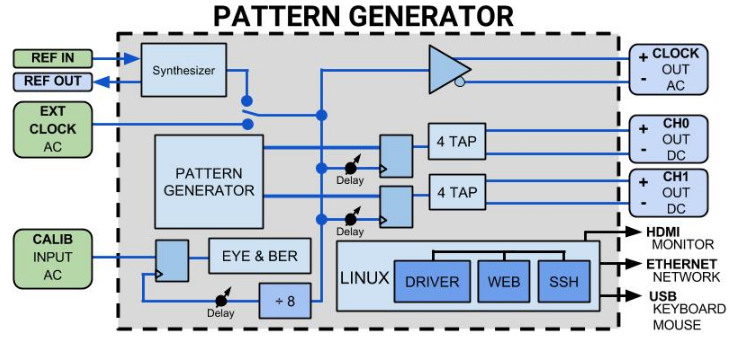Understanding the Pattern Generator
The Pattern Generator provides two differential output signals that can generate PRBS or user pattern NRZ data bits at specified data rates. The data rate is controlled by configuring an internal synthesizer or by selecting to use an externally-provided clock. The output signals may be considered independently or they may be logically linked together to provide separate signals that could be bit-interleaved to create a selected pattern. These signals may be preconditioned with individual 4-Tap preemphasis that can be used to improve signal waveform shape after the signals have traveled through cabling, connectors, and the like. The Pattern Generator also has a unique sub-rate error detector input called the Calibration Input. The Calibration Input is clocked based on the same clock generating output as modified by a selectable sub-rate divider that is needed to limit the the maximum input rate to 3 Gbps. This input can be used to validate signals and test sub-rates for BER and it can be used to view a basic Eye Diagram of the incoming waveform. This feature can be further configured to view the Deferred Eye from an external device making bit decisions by clocking the external device with one output channel, and sweeping the delay time and voltage of the other output channel as the external device makes its bit-decisions.

What's Inside
Inside the Pattern Generator there is a synthesizer for creating a clocking source. Otherwise an external clocking signal can be provided. The clock signal is transmitted out the Clock Output connectors with programmable divide ratios. The clock signal is also used to clock generation of data bits transmitted on the two data output channels. Each channel can be programmed to create PRBS or user pattern bit streams and can be delayed with selectable amounts of timing delay. RF characteristics of each channel can also be preconditioned using 4-Tap preemphasis to shape the the transmitted signal waveforms for the best performance through bandwidth-limited cables and connectors.
In addition, the Pattern Generator contains a sub-rate Calibration input that can be used to examine the eye diagram of a single channel, or even perform BER testing. This input is limited to 3 Gbps sampling, so it is usually used in conjunction with an output channel bit stream that can be sub-divided and still recognized as a testable pattern type. All PRBS patterns meet this requirement.
All of this is controlled via a Linux computer that provides for TCP/IP socket automation and web-browser based user interface control.